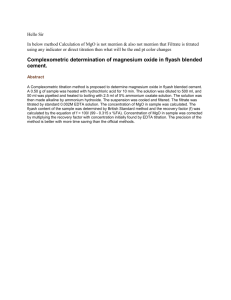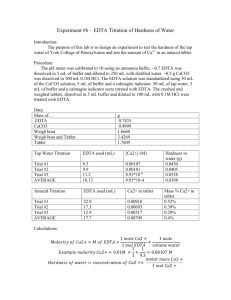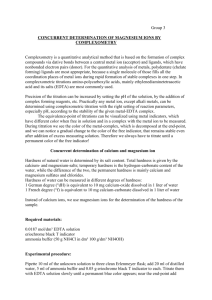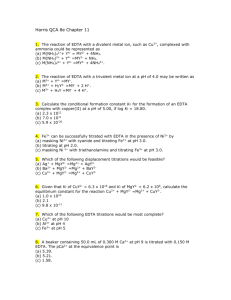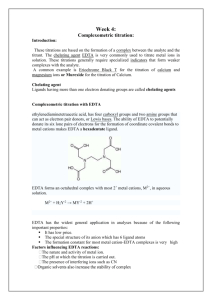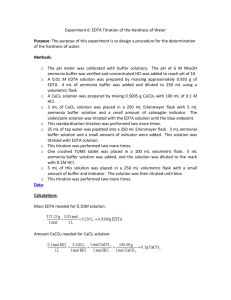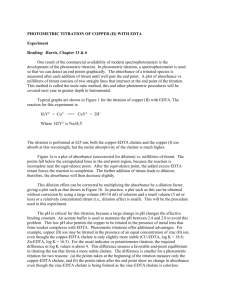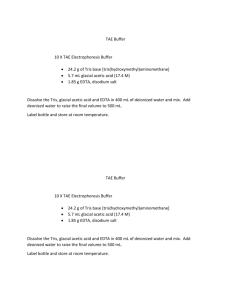Nov quiz 2012 with answers
advertisement
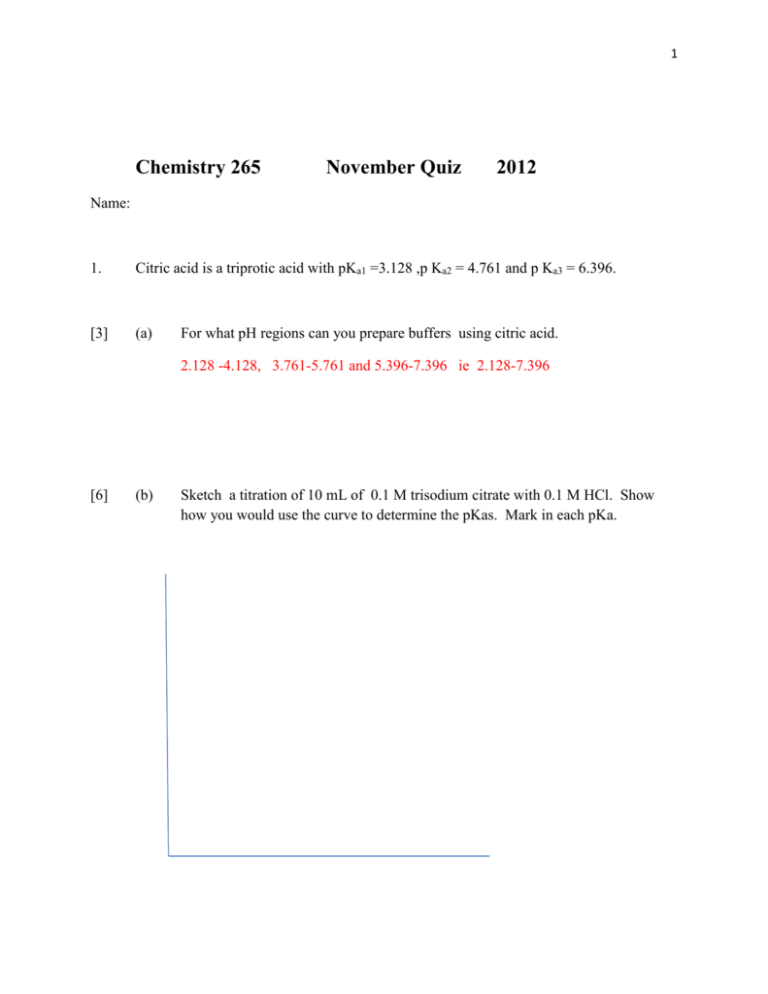
1 Chemistry 265 November Quiz 2012 Name: 1. Citric acid is a triprotic acid with pKa1 =3.128 ,p Ka2 = 4.761 and p Ka3 = 6.396. [3] (a) For what pH regions can you prepare buffers using citric acid. 2.128 -4.128, 3.761-5.761 and 5.396-7.396 ie 2.128-7.396 [6] (b) Sketch a titration of 10 mL of 0.1 M trisodium citrate with 0.1 M HCl. Show how you would use the curve to determine the pKas. Mark in each pKa. 2 [2] (c) Do you actually expect to see 3 distinct steps? Why or why not? No The pKas are rather close, <3 [3] (d) Write the equation for each step in the titration. C3-+ H+ ⇌ HC2HC2- + H+ ⇌ H2CH2C- + H+ ⇌ H3C [5] (e) What is the pH of the 0.1 M trisodium citrate? C3-+ H2O ⇌ HC2- + OH- Kb = Kw/Ka3 Ka3 = 4.02 x 10-7 Kb = 10-14/4.02 x 10-7 = [𝑂𝐻 − ]2 𝐾𝑏 = = 𝐹 2.49 x10−8 ∗ 0.1 = [𝑂𝐻 − ]2 [𝑂𝐻 − ] = 4.99 x 10−5 M pOH = 4.302 pH = 9.698 =9.7 [5] (f) Determine the pH after adding one equivalent of acid. 10 mL added Total volume now = 20 mL. C3-+ H+ ⇌ HC2- 3 [HC2-] = 0.05 M pH = [5] (g) 𝑝𝐾𝑎2 +𝑝 𝐾𝑎3 . 2 = 4.761+ 6.396 2 = 5.578 Determine the pH after adding the second equivalent of acid. 20 mL added. Total volume now = 30 mL. F = 0.033 pH = 𝐾𝑎1 + 𝐾𝑎2 . 2 = 3.128+4.761 2 = 3.944 4 [5] (h) Determine the pH after adding the third equivalent of acid. Total volume 40 mL. 1mmol/40 =0.025 M We will now have a solution of citric acid. quadratic pH = 2.40 5 2. [3] (a) There are several ways to prepare buffers in the lab. I am interested in an acetate buffer. The pKa for acetic acid is 4.76. What is the role of a buffer? Resists changes in pH [3] (b) If I wanted to prepare an acetate buffer, and I had acetic acid and sodium hydroxide, how could I do this? Just give the general idea – I do not need exact amounts. Mix one into the other till required pH is reached. Follow with pH meter [5] (c) If had a 0.200 M solution of sodium acetate and a 0.400 M solution of acetic acid, in what ratio would I need to mix them to give me a buffer of pH 5.2? 5.2 = 4.76 + log [A-]/[HA] 0.4 = + log [A-]/[HA] Let ratio be x:1 for volume ratio acetate to acetic Then 0.4 = log (x. [A-])/[HA] 2.5 =x*.2/.4 so x = 5 so 5:1 6 3. EDTA titrations [3] (a) What is a chelating agent? [2] (b) Give an example of an auxiliary complexing agent. ammonia [3] (c) Calculate Kf’ for the titration of Where log Kf = 13.89 and α4 = 0.30 for EDTA at pH = 10 2.33 x 1013 [2] (d) What is the concentration of free Ca2+ in a solution which is 0.200 F in Ca2+ and 0.1 F in EDTA. It is buffered to pH 11. 0.19 M [4] (e) Name an indicator that is useful for an EDTA titration. Write an equation to show how it works. Indicate the colour change involved. Eriochrome Black T MgIn + EDTA ⇋MgEDTA + In Red Blue



